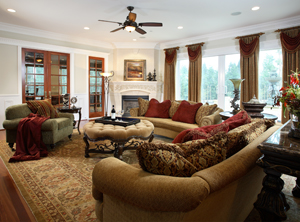 The best way to start dressing any window is to figure out what treatment options are going to work for the window style. Do you need panels on either side of the window to dress up the look or do you need functioning draperies for privacy?
The best way to start dressing any window is to figure out what treatment options are going to work for the window style. Do you need panels on either side of the window to dress up the look or do you need functioning draperies for privacy?
Hardware options are limitless; decorative metal rods and rings can work for a more contemporary look, while wood rods and rings have a warmer traditional look. Drapery panel pleat styles also vary depending on the treatment; use a grommet top for a contemporary look or a French pleat to achieve the traditional style.
Traversing draperies are used to cover an entire window when needed and stack back to one side or split in the middle when they are open. Usually these draperies start above the window and end at the floor with either a puddle for a more traditional look or about a half inch above the floor for a cleaner look. These draperies can run on a battery operated motor or they can be opened and closed with a manual operation, either a wand or chain mechanism.
For a traditional arched top window, try a fun arched fixed panel drapery with medallions mirroring the curve of the window. This will give the illusion that the arch and window are larger than they really are. Add a swag to the front of a fixed panel or between panels to dress up the design.
A valance or cornice box can be used to hide a combination of treatments on one window. This valance should be proportionate to the window it is covering. The treatments below drapery panels, roman shades, or blinds should not be squished or floating freely behind the valance.
Making sure the treatments work together with each other and that they look appropriate in the room is going to make or break the look of the window treatment. Window treatment designs are endless. Find a style that fits your needs and talk to a designer about different, fun options!
